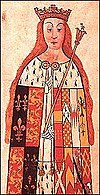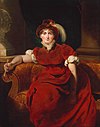|
Princess of Wales
Princess of Wales (Welsh: Tywysoges Cymru) is a title used since the 14th century by the wife of the Prince of Wales. The Princess is the apparent future queen consort, as "Prince of Wales" is a title reserved by custom for the heir apparent to the British throne, and earlier the English throne. The current title-holder is Catherine (née Middleton). When the title was first recorded it was not connected to the English throne; it developed in an independent Wales when it was held by Eleanor de Montfort, the wife of the native Prince of Wales Llywelyn ap Gruffydd. BackgroundPrior to 'Princess' (Welsh: Tywysoges) the title of 'Queen' (Welsh: Brenhines) was used by some spouses of the rulers of Wales. Examples are Angharad ferch Owain, wife of Gruffudd ap Cynan, and Cristin verch Goronwy, wife of Gruffudd's son, Owain Gwynedd (specifically, she was known as 'Queen Dowager').[1] The title in independent WalesJoan (Siwan)Joan, also known as Siwan (her Welsh name), was the illegitimate daughter of King John of England. She was the wife of Llywelyn the Great (initially king of Gwynedd), effective ruler of all of Wales.[2] During her tenure, she used the titles 'Lady of Wales' and 'Lady of Snowdon'. Eleanor de Montfort and Gwenllian Following her wedding ceremony in 1278, Eleanor de Montfort was officially known as princess of Wales.[4][5][6][7] On 19 June 1282, she died giving birth to her first child, Gwenllian.[8] The infant was captured by English forces the following year, after her father, Llywelyn ap Gruffydd, was killed in December 1282. At Edward I's orders, she was kept in the remote Sempringham Priory in Lincolnshire, where she remained until her death in 1337.[citation needed] Gwenllian's status was acknowledged at least once by the English Crown. When writing to the pope, attempting to secure more money for Sempringham Priory, the king stated that "...herein is kept the Princess of Wales, whom we have to maintain". The title 'Princess of Wales' as used here did not have its usual accepted meaning.[9][3] Margaret Hanmer and Catrin, daughter of GlyndŵrMargaret Hanmer, sometimes known as Marred ferch Dafydd (her Welsh name), was the wife of Owain Glyndŵr.[10][11] Some modern historians have accorded her the title 'Princess of Wales'.[12] Catrin was one of the children of Owain Glyndŵr and Margaret Hanmer. In November 1402, she married Sir Edmund Mortimer, the second son of Edmund Mortimer, 3rd Earl of March and through his mother, a great-grandson of Edward III of England.[13] Edmund Mortimer died during the siege of Harlech Castle in 1409, of unknown causes.[14] Catrin was subsequently captured alongside her three daughters, and they were taken to the Tower of London, along with Catrin's mother and one of her sisters. The deaths and burials of Catrin and her daughters are recorded, but the causes of their deaths remain unknown. They were laid to rest at St Swithin's Church in London.[15] List
Spouse of the British (formerly English) heir apparentCecily Neville, wife of Richard of York, 3rd Duke of York, is omitted from this list. While her husband was briefly given various titles, including prince of Wales, by an Act of Parliament as part of his arrangement to succeed Henry VI, he is not generally recognised as such and is not mentioned in any published summary of the topic. Although not granted the title in her own right, the future Mary I was, during her youth, invested by her father, Henry VIII, with many of the rights and properties traditionally given to the Prince of Wales, including the use of the official seal of Wales for correspondence. For most of her childhood, Mary was her father's only legitimate child, and for this reason, she was often referred to as the Princess of Wales, although Henry never formally created her as such. For example, contemporary scholar Juan Luis Vives dedicated his Satellitium Animi to "Dominæ Mariæ Cambriæ Principi, Henrici Octavi Angliæ Regis Filiæ" ("Lady Mary, Prince of Wales, Daughter of Henry VIII, King of England").[21] Welsh politicians suggested that George VI's elder daughter, Princess Elizabeth (later Queen Elizabeth II), be granted the title on her 18th birthday, but he rejected the idea because he felt such a title belonged solely to the wife of a Prince of Wales and the Prince of Wales had always been the title of the heir apparent.[22] Camilla, Charles III's second wife, was the Princess of Wales from 2005 to until she became queen consort in 2022, but did not use the title due to its popular association with her husband's first wife, Diana.[23] On 9 September 2022, a day after his accession to the throne, Charles III bestowed the title of "Prince of Wales" upon his elder son, William, hence making his wife, Catherine, the Princess of Wales.[24] List
See also
Notes
Bibliography
Further reading
|
|||||||||||||||||||||||||||||||||||||||||||||||||||||||||||||||||||||||||||||||||||||||||||||||||||||||||||||||||||||||||||||||||||||||||||||||||||||||||||||||||||||||||||||||||||




















